The Céide Fields are one of the most important archaeological sites in Ireland. It bears witness to the people who lived here on the edge of the cliffs in the north-west of Ireland. There were already settlements here in the Bronze Age – and thus long – very long – before the Celts.
Page Contents (click line to jump the text)
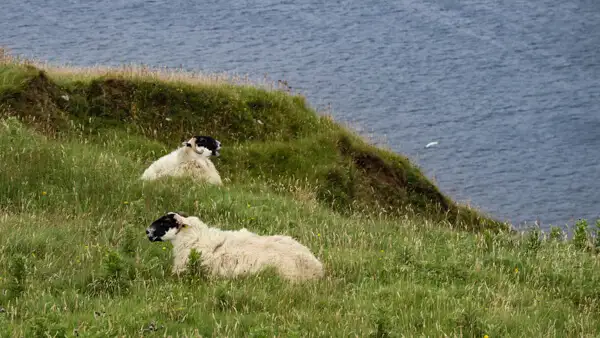
Intro
It had already been a long day on the motorbike. In the afternoon I rode through the Wild Nephin National Park. The ride was beautiful and lonely. I like beautiful – and lonely.
The weather was so moderately beautiful, a grey cloud cover pretty much completely covered the sky and didn’t look like it wanted to move any further. At least it wasn’t raining – or almost. I’m not counting a little drizzle from time to time…
I chugged along the small, lonely road in wide arcs along the Atlantic. Calm sea, little surf, high and steep cliffs. In the background, alternating brown, peaty hills and green pastures. Beautiful here – and not very busy! The Céide Fields are not in the tourist mainstream. I like that.
The cliffs in front of the site are vertical and there is a nice viewpoint. Seagulls circled in front of the wall and the surf broke rather boringly at the foot of the cliffs.

Visiting Céide Fields
A small car park and a strange pyramid broke the pattern. The car park was a welcome break from driving and the pyramid turned out to be the Céide Fields visitor centre. I had vaguely heard about it, not really planning to go here, but having been there before, I decided to take a closer look at the history.
The visitor pyramid turned out to be very nice. There is a small café there, which was just what I needed, and an exhibition on the life of people in prehistoric times in this place.
Without further ado, I join the next guided tour and trudge after the guide in my motorbike boots, out of the building and up the hill.
Here, the small group of visitors mainly sees excavated walls in the boggy ground. Long lines, arches and circles of light-coloured boulders stand out clearly against the vegetation.
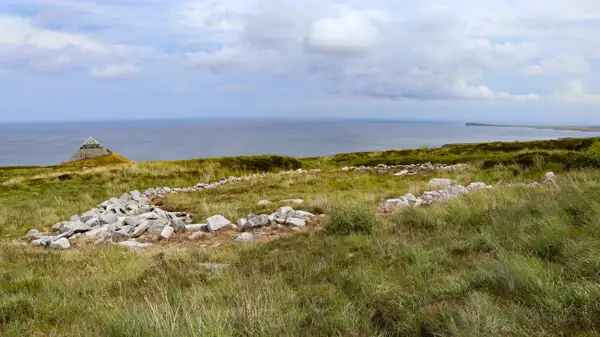
There are many stone circles in Ireland. Circles of standing stones indicate places of worship. Smaller round stone wall remains are probably from beehive huts, i.e. small igloo-shaped huts, and large stone walls are probably ring forts that protected the wooden huts of the clan in their centre.
But these stone circles are of a different nature. They were mainly enclosures for the inhabitants’ livestock, small cattle and goats. The people’s wooden huts have long since crumbled. But the boggy ground has preserved some of the places where the stakes were stuck in the ground. So you can still get an idea of where the dwellings stood and what they probably looked like.
Even more information is provided by the remains of fireplaces and the remains of stone tools and implements, as well as preserved plant and bone remains.
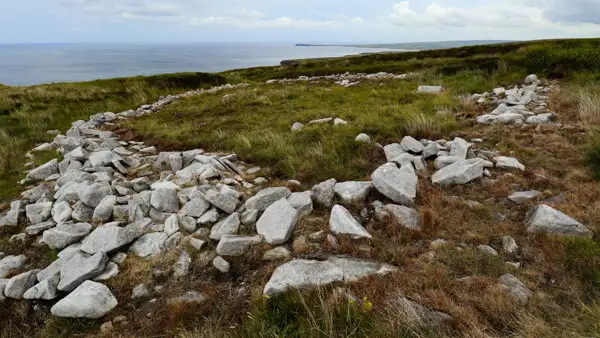
So today we have a rough idea of the fauna and flora of his time, and of the living conditions, diet and tools of the people. We know, for example, that these people also built simple sailing boats, which they probably used to explore the coast in order to settle in suitable places.
We also know that the climate changed. It became colder in the north-east of Ireland and the grazing land suffered as a result. People lived off their livestock and as food became scarcer, they were forced to move further south again.
Where they came from, how long they stayed and where they went – scientists still speculate and puzzle over this to this day.
What makes these early settlers remarkable is the fact that no castles or fortifications have been found to date. Presumably because the people here lived in peace and did not need castles. This is unique on the island, as all later finds of human civilisation always bear witness to the warlike conflicts of their inhabitants.
Peaceful farmers and shepherds in the Bronze Age – they were probably much more advanced in this respect than modern mankind!
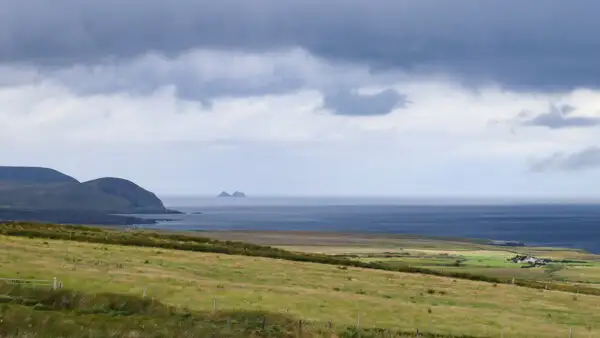
You can find information about the Céide Fields visitor centre here: https://heritageireland.ie/places-to-visit/ceide-fields-neolithic-site-visitor-centre/.
Some background about the Céide Fields
We owe the discovery of the Céide Fields to an observant village schoolteacher and later to his son.
The local villagers traditionally cut peat on the boggy slopes above the cliffs. The peat sods were dried in the air and then used as fuel for the open fires in the cottages. A practice that can still be found in the mountains and hills of Ireland today.
Teacher Patrick Caulfield from Belderrig discovered the remains of walls running deep under the peat here in 1930 – while cutting peat. Educated as he was and obviously inspired by scientific curiosity, he recognised what he found there and continued digging, more or less without public attention.
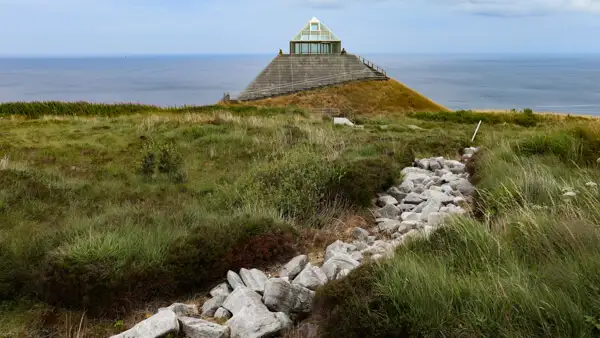
His son Seamus later studied archaeology and publicised the excavations scientifically in the 1970s. Since then, archaeologists have been digging and researching on the huge site – right up to the present day. The full extent of the settlements is still not known. But quite a lot of people lived here around 6000 years ago!
What else you can see in the area
What else can you see in the area? Mountains, sea and moorland! Seriously, the area is characterised by its beautiful landscapes and coastline.
South of Bangor Erris is the Wild Nephin National Park. A beautiful hilly park with a very special fauna and flora invites you to visit and walk. See: https://www.nationalparks.ie/wild-nephin/.
To the south-east of the Céide Fields and not far away is the pretty town of Ballina and a little further on is the coastal town of Enniscrone.
Beautiful beaches can be found at Ballycastle Beach, Lacken Strand and Rinroe Beach.
Downpatrick Head is a small headland not far from the Fields. There you will find a picturesque rock needle in front of the steep cliffs, the Eire64 sign and also a blowhole, which is a hole in the rock through which the surf enters.
Killala is a small, pleasant coastal town. Killala Quay is located in a large, sandy bay and is simply beautiful. You’ll also find one of the typical Irish round towers from the Middle Ages in Killala.
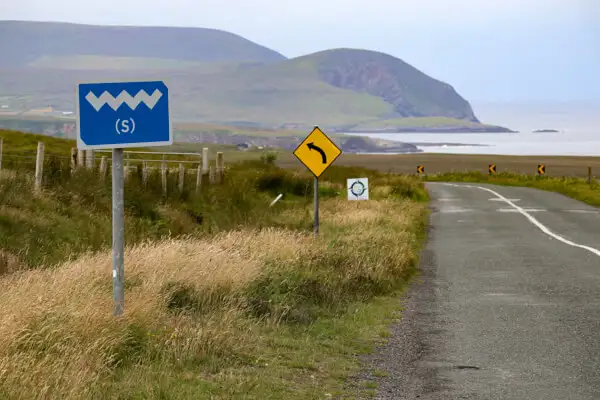
Conclusion
If you are interested in rural, unspoilt Ireland, if you like to see great landscapes and coastlines and if you like to get away from the tourist hustle and bustle, then the north-west of Ireland is the place for you.
The Céide Fields are a very interesting sight on your journey through the wild north-west. Probably the first settlers on the island of Ireland lived here in this place about 6000 years ago – it doesn’t get more original than this!
I wish you a great tour in the north-west of Ireland and lots of fun at the Céide Fields.
I have linked a few interesting articles for you here:
More interesting articles for you
THE ROCKY BURREN – A VERY SPECIAL LANDSCAPE IN IRELAND
DROMBEG STONE CIRCLE – THE MEGALITHIC HERITAGE OF IRELAND
THE CLIFFS OF SLIEVE LEAGUE – MAJESTIC AND MARVELLOUS
THE ANCIENT STONE-HOUSES OF DINGLE
Picture credits cover picture: Ceide Fields Visitor Centre, photo: Ulrich Knüppel-Gertberg (www.irland-insider.de, www.ireland-insider.com)